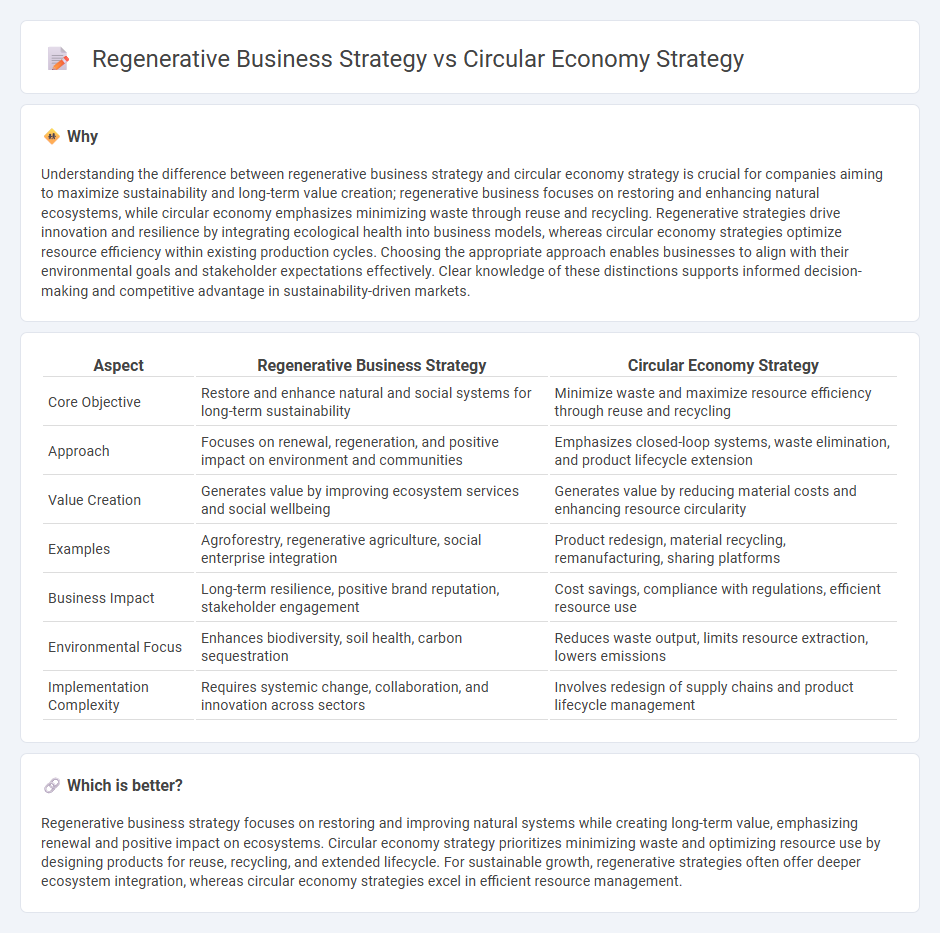
Regenerative business strategy focuses on restoring and revitalizing ecosystems while creating positive social and economic impacts, going beyond sustainability to actively improve resources and communities. Circular economy strategy aims to minimize waste and maximize resource efficiency through reuse, recycling, and closed-loop systems to achieve sustainable growth. Explore the differences and benefits of these strategies to drive innovative and impactful business models.
Why it is important
Understanding the difference between regenerative business strategy and circular economy strategy is crucial for companies aiming to maximize sustainability and long-term value creation; regenerative business focuses on restoring and enhancing natural ecosystems, while circular economy emphasizes minimizing waste through reuse and recycling. Regenerative strategies drive innovation and resilience by integrating ecological health into business models, whereas circular economy strategies optimize resource efficiency within existing production cycles. Choosing the appropriate approach enables businesses to align with their environmental goals and stakeholder expectations effectively. Clear knowledge of these distinctions supports informed decision-making and competitive advantage in sustainability-driven markets.
Comparison Table
| Aspect | Regenerative Business Strategy | Circular Economy Strategy |
|---|---|---|
| Core Objective | Restore and enhance natural and social systems for long-term sustainability | Minimize waste and maximize resource efficiency through reuse and recycling |
| Approach | Focuses on renewal, regeneration, and positive impact on environment and communities | Emphasizes closed-loop systems, waste elimination, and product lifecycle extension |
| Value Creation | Generates value by improving ecosystem services and social wellbeing | Generates value by reducing material costs and enhancing resource circularity |
| Examples | Agroforestry, regenerative agriculture, social enterprise integration | Product redesign, material recycling, remanufacturing, sharing platforms |
| Business Impact | Long-term resilience, positive brand reputation, stakeholder engagement | Cost savings, compliance with regulations, efficient resource use |
| Environmental Focus | Enhances biodiversity, soil health, carbon sequestration | Reduces waste output, limits resource extraction, lowers emissions |
| Implementation Complexity | Requires systemic change, collaboration, and innovation across sectors | Involves redesign of supply chains and product lifecycle management |
Which is better?
Regenerative business strategy focuses on restoring and improving natural systems while creating long-term value, emphasizing renewal and positive impact on ecosystems. Circular economy strategy prioritizes minimizing waste and optimizing resource use by designing products for reuse, recycling, and extended lifecycle. For sustainable growth, regenerative strategies often offer deeper ecosystem integration, whereas circular economy strategies excel in efficient resource management.
Connection
Regenerative business strategy and circular economy strategy both focus on sustainability by minimizing waste and enhancing resource efficiency through closed-loop systems. Regenerative business strategies aim to restore and renew ecosystems while circular economy models prioritize the continuous reuse of materials, reducing dependency on finite resources. Integrating these approaches drives innovation in sustainable supply chains, lowers environmental impact, and fosters long-term economic resilience.
Key Terms
Resource Efficiency
Circular economy strategies prioritize resource efficiency by minimizing waste through reuse, recycling, and optimizing material flows to extend product lifecycles. Regenerative business strategies go further by restoring and enhancing natural systems, aiming not just for sustainability but for the renewal of ecosystems and communities. Explore the nuances and benefits of these approaches to propel your business toward sustainable growth.
Ecosystem Restoration
Circular economy strategies prioritize resource efficiency by minimizing waste through reuse, recycling, and closed-loop systems, aiming to extend product lifecycles and reduce environmental impact. Regenerative business strategies go beyond sustainability, actively restoring and enhancing natural ecosystems by integrating practices that improve biodiversity, soil health, and water quality. Explore how adopting regenerative approaches can drive ecosystem restoration and create long-term value for both businesses and the planet.
Closed-Loop Systems
Circular economy strategies prioritize closed-loop systems by minimizing waste through recycling, reuse, and resource efficiency to maintain product lifecycle integrity. Regenerative business strategies emphasize restoring and enhancing ecosystems alongside economic activities, integrating closed-loop systems that contribute to environmental renewal and social well-being. Explore how adopting these approaches can transform business models and drive sustainable development.
Source and External Links
Circular economy action plan - Environment - European Union - The EU's Circular Economy Action Plan promotes sustainable product design, circular processes, and waste prevention as core strategies to reduce resource pressure, achieve climate neutrality by 2050, and support sustainable growth and jobs.
R-Strategies for a Circular Economy - The R-strategies hierarchy outlines 10 circular economy approaches from refusing and rethinking product use to recycling and recovery, emphasizing shorter waste loops like reduction and reuse as more sustainable.
Circular Economy as a Climate Strategy - Circular economy strategies are grouped into reducing material inputs, keeping products in use, cycling materials back through recycling, and regenerating natural systems, all contributing to climate goals by reducing raw material demand and emissions.
 dowidth.com
dowidth.com